Published Planet Candidates from Planet Hunters NGTS!
Good news everyone! Our paper describing the Planet Hunters NGTS project and presenting the first 5 planet candidates discovered by the project has been published in the Astronomical Journal!
The paper goes into the nitty gritty details of how the project operates, how we combine all the responses we received for the first dataset we uploaded (over 2.6 million individual classifications!) and how the list of planet candidates are selected for further observations. The most exciting part of the paper is the section where we present the 5 new planet candidates found by you, the citizen scientists! These planet candidates were not previously identified by the NGTS team or as TESS Objects of Interest, meaning some of you were the first people to ever suspect these could be possible planets. The paper includes a link to the project results page which lists the names of all the citizen scientists who classified these candidates at any stage of the project and you can find that list here too! Although none of these candidates are “confirmed planets” yet, we’re continuing to gather and analyse more data on each of them and hope to announce the confirmation of one or more of these planet candidates in the near future. Even at this stage, these candidates are interesting discoveries, in particular the excitingly named TIC-165227846 and TIC-135251751, which I’ll give a bit more detail on below.
TIC-165227846 is an exciting system as it’s a rare find. We think this could be a giant planet (bigger than Jupiter) orbiting very close to a low-mass star known as an M-dwarf. There’s only around 10 of these systems that have been detected so far and, if confirmed, ours would be the lowest mass star to host a close-in giant planet discovered to date! These types of systems are interesting because, quite simply, we don’t think they should be able to exist. A newly formed star can be surrounded by what we call a “protoplanetary disk,” which is a load of dust and gas that provides the material necessary to form planets. We currently believe that most planets form via “core accretion” where this dust and gas sticks together and forms a planet over time. However the amount of material available in the protoplanetary disk correlates with the mass of the star, therefore a low-mass star such as this will have less material available to form such a large planet! Another barrier is the time it takes for a planet to form around a low-mass star is longer (the lower mass means that things move more slowly around it) but planet formation is on a time limit as the protoplanetary disk gets dispersed as the star evolves. By discovering interesting systems such as TIC-165227846 that challenge our current theories of planet formation, we can test and tweak our models to gain a better understanding of how planets come to exist.
TIC-135251751 is an interesting system with an even more interesting story of how we came to learn (part of) its true nature. When we first discovered this system, we thought we were seeing a giant planet orbiting close to an ageing star, known as a subgiant. Don’t be fooled by the name though as this star apparently had a radius 2.4 times that of our Sun. These kinds of systems are interesting because we don’t often expect to find planets close to stars that are evolving into the later stages of their lifecycle. This is because these stars begin to expand and can engulf any planets close to them. However, one of the key steps in validating whether or not a possible transit signal is really due to a planet is to obtain speckle imaging, which you can read more about here. In short, speckle imaging allows us to observe close to the host star to see if there are any other stars nearby that could be affecting our measurements. When we observed TIC-135251751 using the Zorro instrument at Gemini South, the wonderful Zorro team found that this star was actually two stars in a binary system! Though it doesn’t look like much, the slightly elongated shape of the red spot in the inset of the figure below is the evidence that tells us that this system is not as it initially seemed.
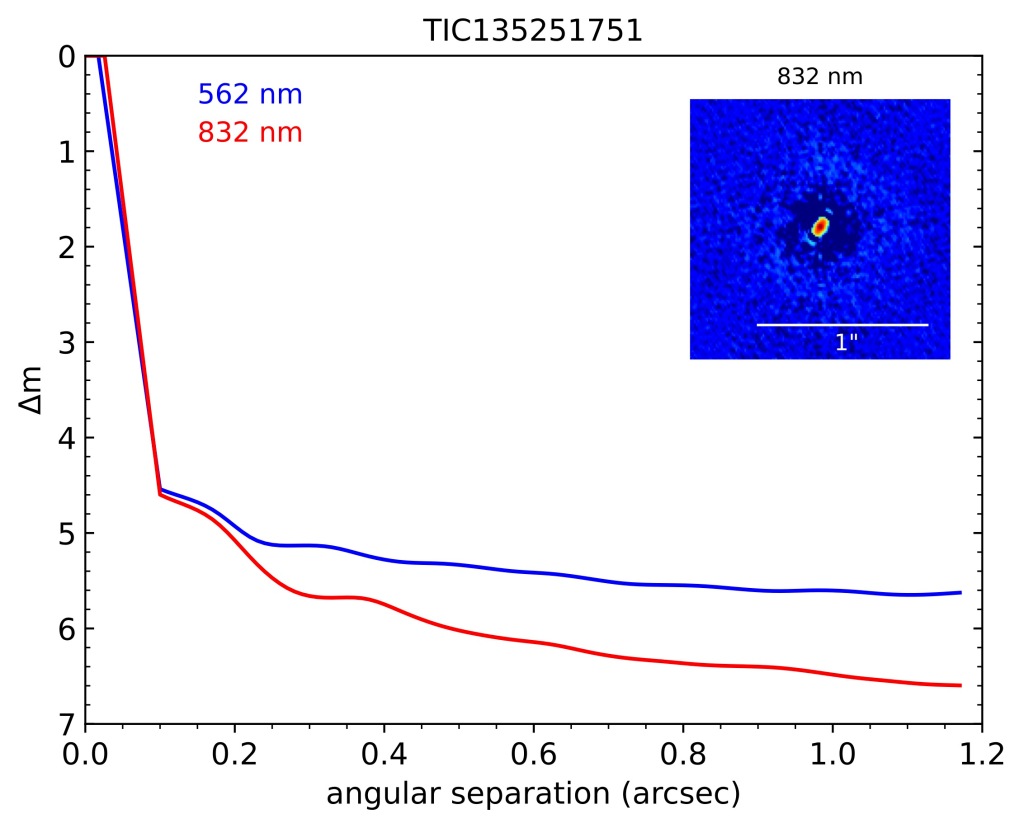
While initially disheartening to find that we were actually looking at two stars, meaning that further observations and analysis would be challenging, the reality is that the transiting signal we detect is possibly still due to a planet and is not a result of the 2 stars passing in front of each other (like an eclipsing binary). These stars are orbiting with a period of ~50 years while the transit signal occurs approximately every 4 days. We could be observing a planet orbiting one of the two stars in this close binary system which would be another interesting discovery for Planet Hunters NGTS as these types of systems also pose interesting questions for our theories on planet formation.
This paper and these discoveries are just the first step for Planet Hunters NGTS. We will continue to analyse these systems with the belief that we can report the confirmation of a bonafide planet soon. Meanwhile, we’ll continue to analyse the newer datasets as classifications roll in, including the latest data from NGTS which is live on the site now and hasn’t been looked at by anyone before. This means that you could be the first person to spot a new planet in the NGTS data, so get classifying and maybe one day we’ll be publishing a paper with a discovery you helped find!
A week in the life of an observer
Last month I had the privilege of observing at the Telescopio Nazionale Galileo (TNG) at the Roque de los Muchachos Observatory on La Palma. It’s convenient that often the conditions required for excellent observations are the same as what you’d look for in a warm holiday destination, although when you’re working night shifts there isn’t much time for sunbathing. Located at an altitude of 2,370 metres on the edge of La Caldera de Taburiente, the TNG is home to five instruments: SiFAP2, Nics, Dolores, GIANO-B and HARPS-N. We primarily used the HARPS-N instrument, or to give it its full name: the High Accuracy Radial velocity Planet Searcher for the North hemisphere, because astronomers love an acronym. This instrument is designed to measure the radial velocity signal of stars. This is a technique that essentially detects how much a star is “wobbling,” from which we can determine the minimum mass of any orbiting body (if it’s low enough, then we have a planet!).
With no direct flights between Belfast and La Palma, we had to make a brief stopover in Tenerife before arriving in La Palma the following morning. A quick taxi ride up the mountain road and we reached the Residencia which would be our home for the next 9 days. Our observing run didn’t start until the next night which meant we had plenty of time to watch the sunset. The images below show the three other terrestrial planets in our Solar System with Venus shining bright near the horizon, Mercury (a rare sighting!) a short distance up and right of Venus, and Mars a bit further away up and to the left. Since my phone camera isn’t quite as good as a 3.58-metre, world-class telescope, I’ve annotated the image so you can be sure that those aren’t just smudges on your screen.
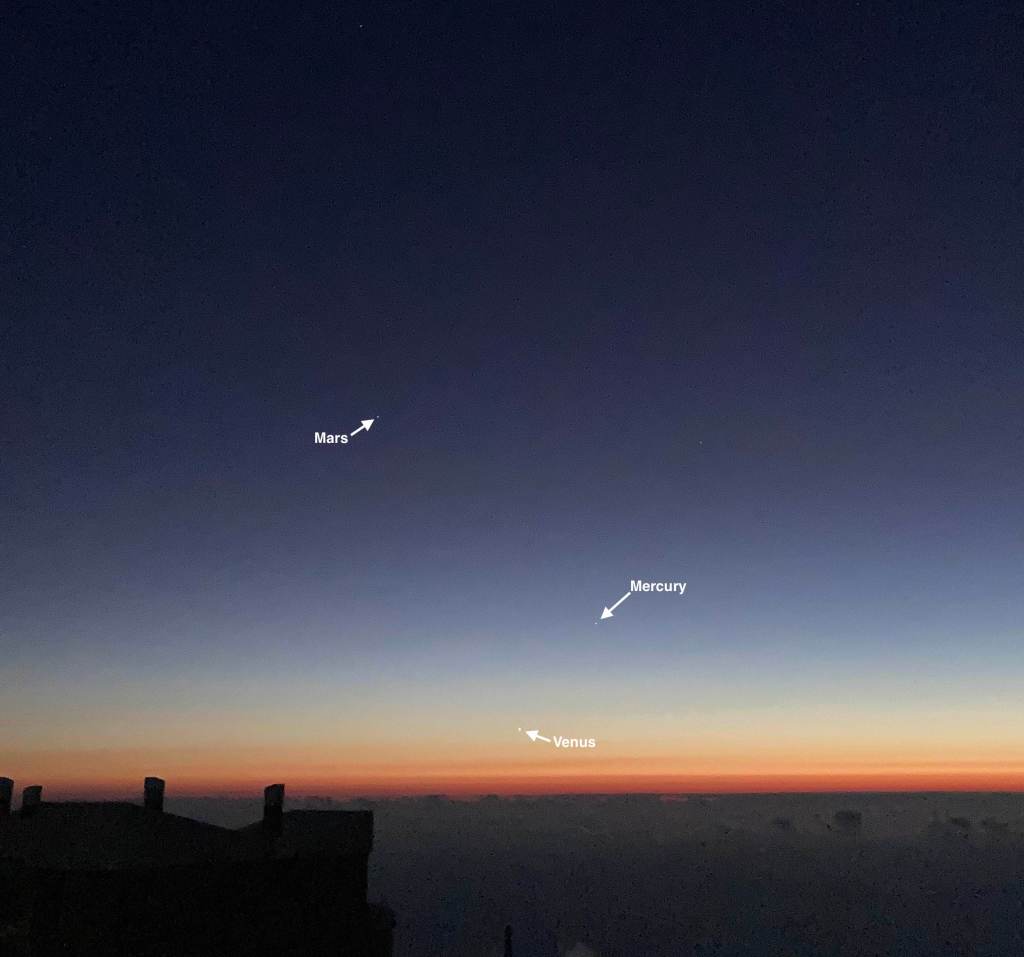
The typical “day” when on an observing run (in Summer, when the nights are short!) is as follows: Wake up around 3:30pm, grab a quick breakfast and head up to the telescope at 5pm to start calibrations and schedule the target list. Depending how quick we get calibrations done, we have some time to kill before eating dinner as late as possible then heading back up to the telescope for sunset (which for us is around 9pm). After watching the Sun dip below the horizon, we head into the telescope control room to review the schedule for the night, check the weather forecast to make sure there aren’t any pesky clouds inbound and, if needed, look for backup targets that can be observed in poor weather. We start scientific observations at the end of nautical twilight, which is when the horizon is no longer visible (so-called as this is the period when sailors could navigate using bright guide stars while still having sight of the horizon). Assuming the weather is clear and the telescope doesn’t have any technical faults, observing a set list of targets is quite straightforward and we continue to observe until the end of nautical night which is around 6:30am. After filling out the night report detailing what we observed and any issues that may have occurred, we head back down to the Residencia and get to bed around 7am to get as much sleep as possible before starting the same routine all over again.
Our first three nights of observing went pretty smoothly, with remarkably good conditions on night two. The seeing (a measure of how good your image quality is due to turbulence in the atmosphere) reached 0.19 arcseconds! I’ve provided a cartoon below to put into context how good the conditions were:
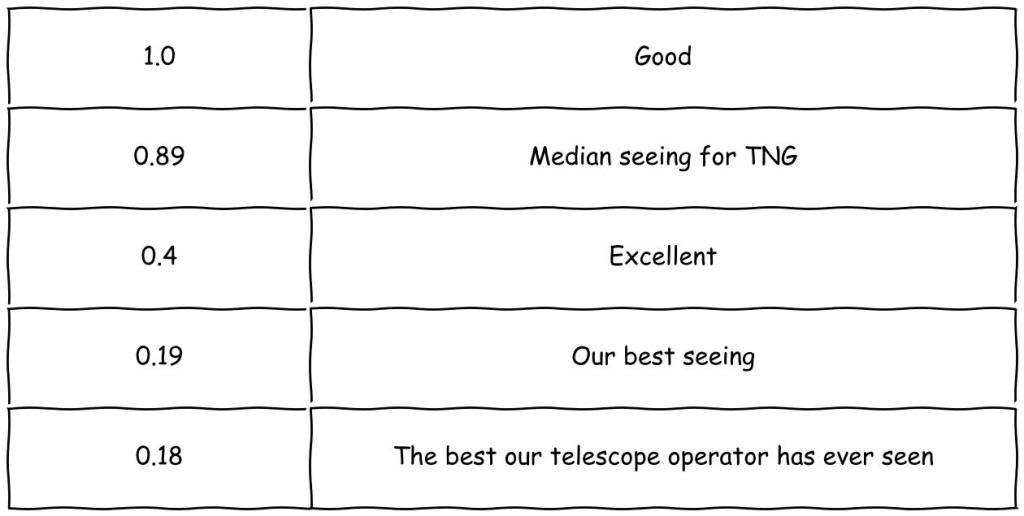
We passed some of the time getting other work done (as best we could when adjusting to a night shift) but mostly we played card games while checking that the observations were still on track. During our free time in the day, we took the opportunity to go up to the summit of the Roque de los Muchachos, which provides stunning views into the caldera (the remnants of a huge volcano crater) and across the island of La Palma. In the distance we could see the site of the 2021 Cumbre Vieja volcanic eruption which is still smoking to this day.

The fourth night of our observing run marked the midway point, and the weather had taken a comparative turn for the worse with high-level cloud rolling in throughout the night, disrupting our observations and leaving us to chase targets that were in any gaps we could spot. These conditions are more typical of an observing run, with variable conditions and time lost waiting for clouds to pass, so it was a useful experience to learn how to react when the weather won’t play nice.

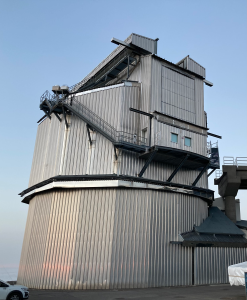
The forecast for night 5 looked as though it could go the same way as the previous night, but luckily the clouds kept dissipating before they reached us. The final two nights of the observing run also went smoothly which gives me the opportunity to talk a bit about the interesting history of the TNG’s design. The TNG’s design is derived from that of the New Technology Telescope (NTT) which is located at La Silla Observatory in Chile. As the name suggests, the NTT pioneered many of the technologies which are widespread on many of the best telescopes today. It implemented active optics, where the mirrors are adjusted during observations in order to correct for atmospheric effects and preserve the image quality. Most large telescopes have historically been built with spherical domes whereas the NTT and TNG use an octagonal enclosure which is designed to reduce turbulence due to air passing over/through the telescope structure which again results in a better image quality. These technological advancements have been applied to, most notably, the Very Large Telescope (VLT) at Paranal Observatory in Chile (just a few kilometres away from NGTS!).
Finally, I’d like to thank the Royal Astronomical Society who kindly provided financial support to help me go on this trip. I had an amazing time and learned a lot about how astronomical observations are actually done, which will no doubt be a useful skill in my future career as an astronomer.
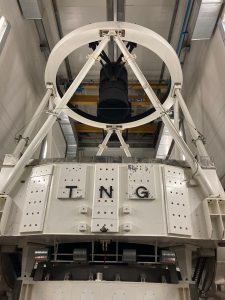
Subject to Candidate to Planet: The Task of Zorro
If we’re confident that there is a real transit signal coming from a given star, we can apply for an allocation of time to use the Zorro speckle imager on the Gemini South telescope (which is a huge 8-metre telescope in Chile). This instrument takes lots of images of the star in quick succession, which allows us to “freeze out” the effects of the Earth’s atmosphere that causes light from stars to be distorted (similar to the distortion that causes stars to twinkle). This allows us to determine whether there are any nearby stars that might be contaminating our measurements. If a star were close enough that some of its light was “leaking” into our measurements of the candidate then we’d see a smaller transit depth than is actually the case. This would mean that we’d be underestimating the radius of the orbiting body which could mean that what we believe to be something the size of a planet could actually be the size of a star!
Below is a plot showing real data from the Zorro instrument on Gemini South for one of the most promising planet candidates from Planet Hunters NGTS (Subject 69654531 which you can read more about by clicking this link). The two different lines show data for two different wavelengths of light. The human eye typically sees light with any wavelength between 380 and 750 nanometres, but telescopes can focus on ranges centred around specific wavelengths with various filters. In this case, the telescope splits the beam of light (with a component called a dichroic) so that redder light (centred on 832 nm) goes to one camera while bluer light (centred on 562 nm) goes to the other. These two different measurements are shown in red and blue respectively on the plot below and allow us to obtain simultaneous two-colour imaging of the target.
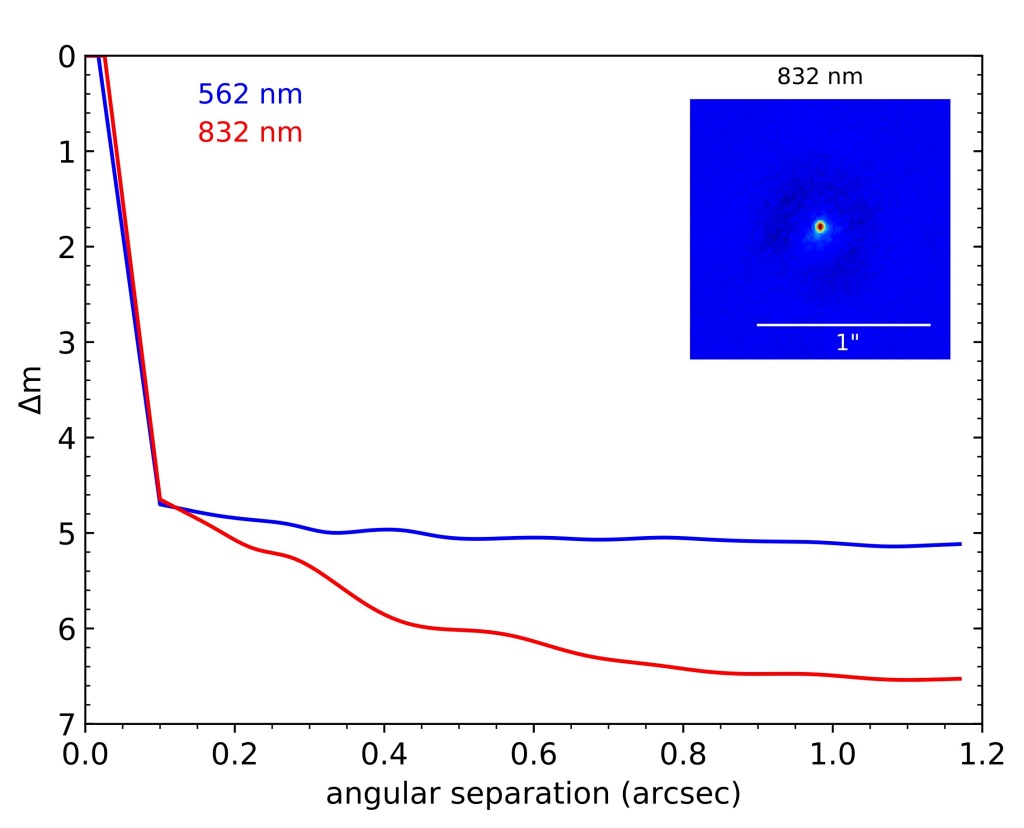
The horizontal axis of this plot shows angular separation from the star in arcseconds, which is a unit used to measure the distance between points in the night sky (e.g. the Moon distance from one side of the moon to the other as you look at it from Earth is 1,900 arcseconds). The vertical axis is called “contrast” or “magnitude difference” and indicates how much dimmer the region around the star is compared to the star itself in units of apparent magnitude. What this plot shows is that between 0.1 arcsecs and 1.2 arcsecs, there aren’t any stars with an apparent magnitude within about 5 magnitudes of the target star’s brightness which lets us know that there probably isn’t a nearby star at these separations (although there could still be something really close in!). Using the results of these observations, we can be more confident that the transit we’re observing is “on target” (i.e. coming from the star we think it is) and we can have a more confidence in our estimates of the radius of our planet candidate as we know the levels of contamination aren’t significant. This gives us the necessary belief to push ahead with further follow-up observations which I will describe in the next part of this blog post series.
From subject to candidate to planet: Checking in with TESS
Once we have identified an object as a potential planet candidate from the NGTS data, the first step is to check whether we also see the transit signal in data from the Transiting Survey Exoplanet Satellite (TESS). Let’s walk through an example of one of the subjects that we initially thought was a planet candidate, Subject 69693101. The Planet Hunters NGTS light curve for this object looks promising. Also the odd/even and secondary eclipse (not shown) light curves look fine too and when we analysed the NGTS data we estimated a radius of 1.35 Jupiter radii for the orbiting body, which is big but not so big that we would immediately rule it out.


Therefore, we decided to check the TESS data for this star. Luckily TESS has observed this star in two “sectors” which means we have approximately 2 months worth of data to look at (TESS observes a region of the sky, called a sector, for a month at a time before moving on, but has is now revisiting regions to gather more data). The plot below shows the light curves for both sectors with the x-axis showing time in days since a fixed date. (Astronomers like to use a unit called Julian Days which is the number of days since January 1st 4713 BC, but this number is huge so we subtract standard values to make the numbers more manageable, in this case we’ve subtracted 2457000 days).
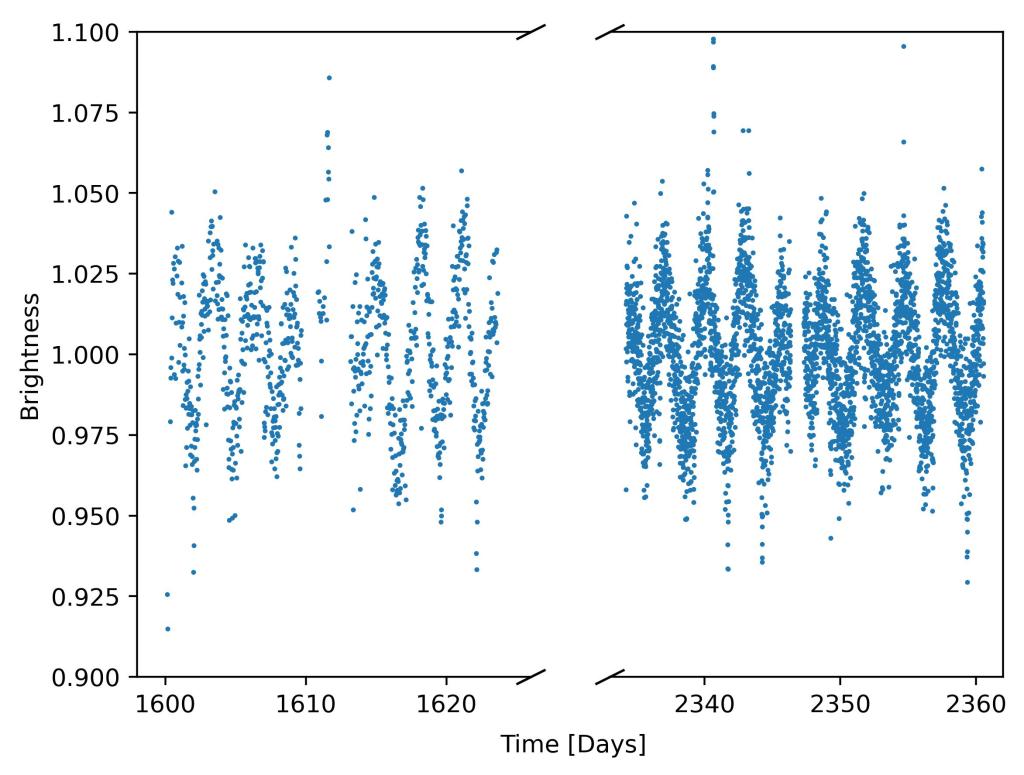
At first look, this star looks to be very variable, possibly due to some intrinsic stellar variability although periodic signals like this can be as a result of it being a binary star system. The first step is to try phase folding the data onto the period found by NGTS. This is a process where we take each section of the lightcurve that corresponds to (what we believe to be) one orbit of the candidate, centred on the transit, and plot the data on top of each other. This means that the transits should all be in the middle of the plot. The plot below shows the data folded onto the 2.51 day orbit that NGTS detected, with grey points showing the raw data and red points showing the data binned in 10-minute averages.
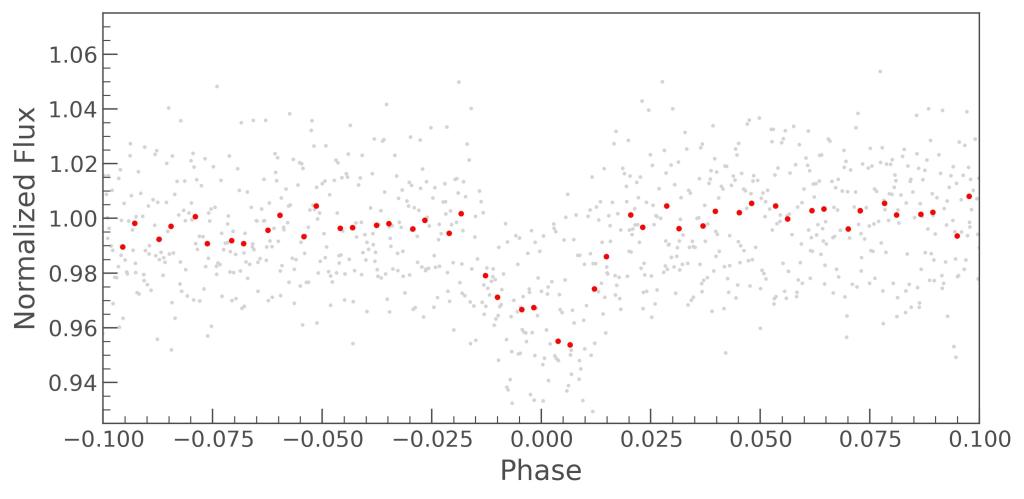
This looks like a clear transit signal, although the apparent variability of the star made me cautious when looking at this. Therefore, I tried folding the data to twice the detected period and, voila, we can clearly see two transits of differing depths which tells us that this is indeed an eclipsing binary system and not a planet candidate. While it’s unfortunate that this particular candidate isn’t a planet, it does mean we can focus our time and resources on more promising candidates that might really be planets!
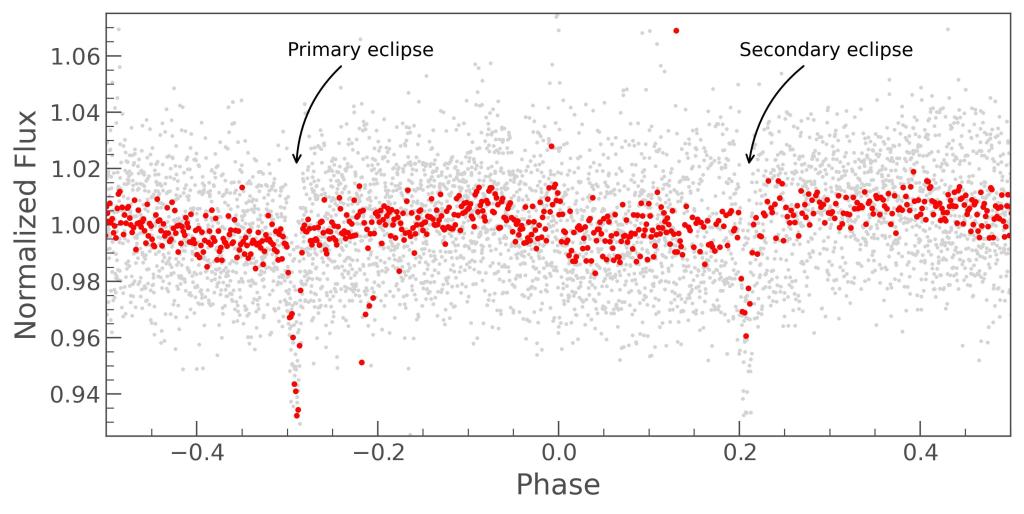
From subject to candidate to planet: Processing all that data
You may be wondering how a subject goes from being one of thousands of subjects in the Planet Hunters NGTS project to becoming a candidate and then, hopefully, a bonafide planet! In this series of posts I hope to shed some light on the life cycle of a Planet Hunters NGTS subject.
Once a set of subjects are “retired” from the site, which occurs when all the subjects have received responses from at least 20 unique users, the data is collected from a huge “csv” file (that stands for comma-separated values). This contains every response by every volunteer for every subject included in the project and is effectively a giant spreadsheet, albeit one with millions of rows that would crash any standard spreadsheet viewer like Excel. This huge file is processed by a computer program and the most important data is pulled out and inputted into a large database that forms the hub of our operation.
From here, I can run another program that iteratively calculates scores for each subject for each possible response and computes weights for each user so that we can pay more attention to the classifications that identify transits more easily and therefore pick out subjects with high scores that might have been missed with simple vote counting. This is similar to the scoring and weighting schemes used in the Planet Hunters and Planet Hunters TESS projects, as well as many other citizen science projects. This lets me generate a list of the most promising candidates (e.g. subjects that are probably U-shaped) which are what you’ll see in the Secondary Eclipse & Odd/Even Transit Checks. I can then apply a similar program to classifications in these workflows to identify the subjects that are most likely to not have secondary eclipses or transit depth differences. These are the strongest candidates for being planetary transits instead of eclipsing binaries.
The next step is the most arduous as I look through all these candidates by eye (and there’s usually a lot of them!) and pick out the most promising ones to get a second opinion on. Filled with optimism and with candidates in hand, I show these to the NGTS team who evaluate them as a group to pick out the most promising planet candidates that we think are worthy of further investigation. At this point we would class these objects as potential planet candidates, although they can be ruled in or out through a series of tests using different data sources that I will go into in later blog posts.
Planet Hunters NGTS: A mysterious festive transit
We’ve spotted another transiting object around a star! With unprecedented image resolution we have captured the transit of this festive phenomena seen in the animation below.
The transit has a depth of ~6.5% around this small star that has a radius of only 0.4 Solar radii. That means that we can estimate the size of the transiting object (assuming a spherical Santa) to be R = 9.73 x 0.4 x sqrt(0.065) = 1 Jupiter radius! There were hopes that this would be an Earth ana-yule-logue with a Jingle Bell Rock-y composition but it seems to be a Ho-Ho-Hot Jupiter. The shape of the light curve is more similar to an exo-comet which means that it must be accompanied by an exo-cupid. Further observations will be required to identify additional exo-reindeer. Following its confirmation the festive object has been given the moniker HAT-P-Christmas.
Thank you to my fellow PhD students: Joe Murtagh, for drawing the silhouette of Santa and his reindeer; Lucy Dolan and David Jackson, for their festive-themed exoplanet puns. Merry Christmas and Happy Holidays to all!
Planet Hunter NGTS at the UK Exoplanet Meeting 2022
This week, I was in Edinburgh for the UK Exoplanet Meeting 2022 (UKExom22, for short) where I presented details of the project and the results so far from Planet Hunters NGTS, including details on our 4 new planet candidates. This was an opportunity to showcase the brilliant work of the Planet Hunters NGTS volunteers to an audience of over 100 exoplanet astronomers based in the UK, as well as a chance to meet (in some cases for the first time!) and speak with members of the NGTS team who have been working hard to help us vet the best candidates from the project and coordinate follow-up observations.
The first day of talks included some exciting results from the new JWST mission as well as techniques being employed to try and detect Earth-analogues which are currently difficult to find due to stellar activity! Later in the afternoon, I gave a 12-minute presentation describing why citizen science is so great, how Planet Hunters NGTS works and what we know so far about our new planet candidates. There was plenty of interest in the project from the audience who were impressed by both the enthusiasm of the Planet Hunters NGTS volunteers and the fact we already have four new planet candidates from our very preliminary analysis.
Day two of the conference started with more interesting talks including hearing about the current status of the PLATO mission and the results of the ASTEP telescopes that are helping the hunt for exoplanets at an observatory out in Antarctica! The relaxed schedule of the afternoon provided the opportunity for me to meet with another member of the Planet Hunters NGTS team, Sam Gill, who can fit the NGTS data with better models than the initial search to provide us with more accurate estimates of the planetary radius. Below is an image of the output of Sam’s work, showing more plots of each transit and the phase folded light curve fitted with a more accurate model. I was also able to speak with Matt Burleigh and Alicia Kendall, collaborators from NGTS who obtained more photometry of some of our candidates discussed in the previous blog post and will be able to combine data from multiple data sources to provide us with a more accurate radius estimate for Subject 69654531.
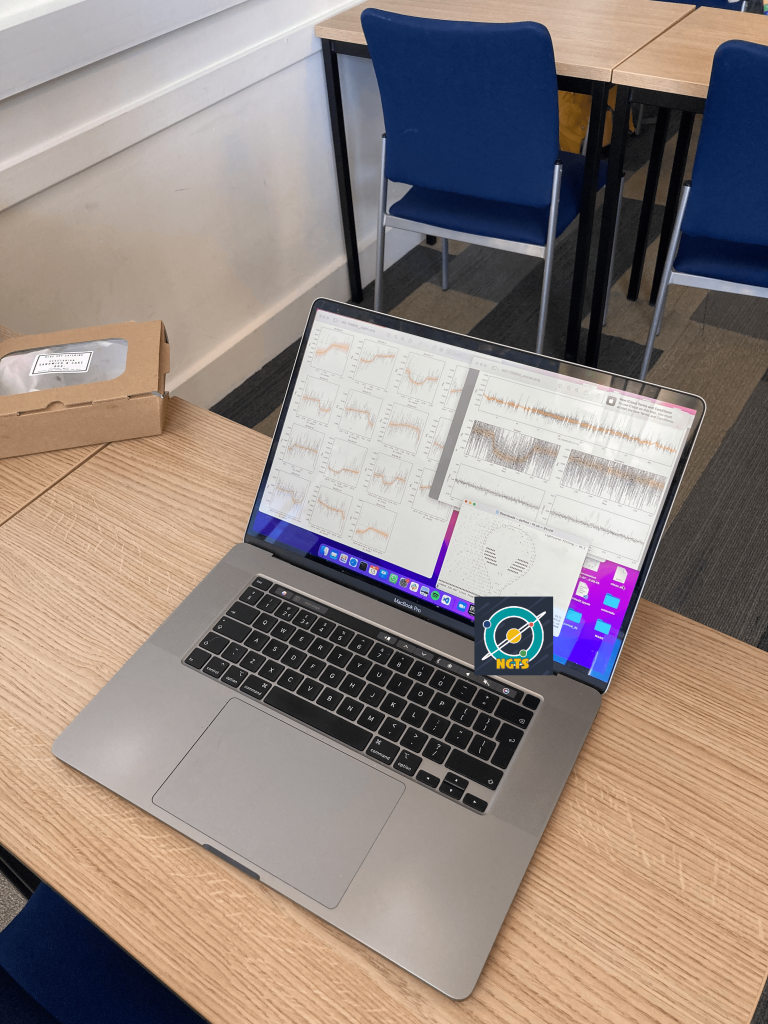
It’s not all about science at a conference as Tuesday evening saw many make the short trek up Blackford Hill which is home to the Royal Observatory Edinburgh and provides excellent views of Edinburgh Castle, Arthur’s Seat and the sunshine on Leith. The conference dinner and a trip to a Karaoke bar that had a large number of astronomers attempting to sing Bohemian Rhapsody capped the second day of the conference.
The final day of the conference included talks on improved techniques for measuring the radial velocity of stars which will allow more accurate measurements of exoplanets and the first direct detection of planetary material being accreted by a white dwarf. This discovery was made by detecting 5 (yes, only five!) X-ray photons being emitted by a white dwarf which was then determined to be due to remnants of a planet falling into the atmosphere of the white dwarf.
That brought to an end my first in-person UK Exoplanet Meeting and I’m already looking forward to next year’s meeting that will be hosted by UCL in London! In the meantime, I’ll be vetting more candidates from the project and coordinating follow-up observations as well as considering applying for additional observing time that would potentially help us get closer to validating or confirming some of the candidates already mentioned or any others that we find in the coming months. Keep an eye on the blog to stay tuned!
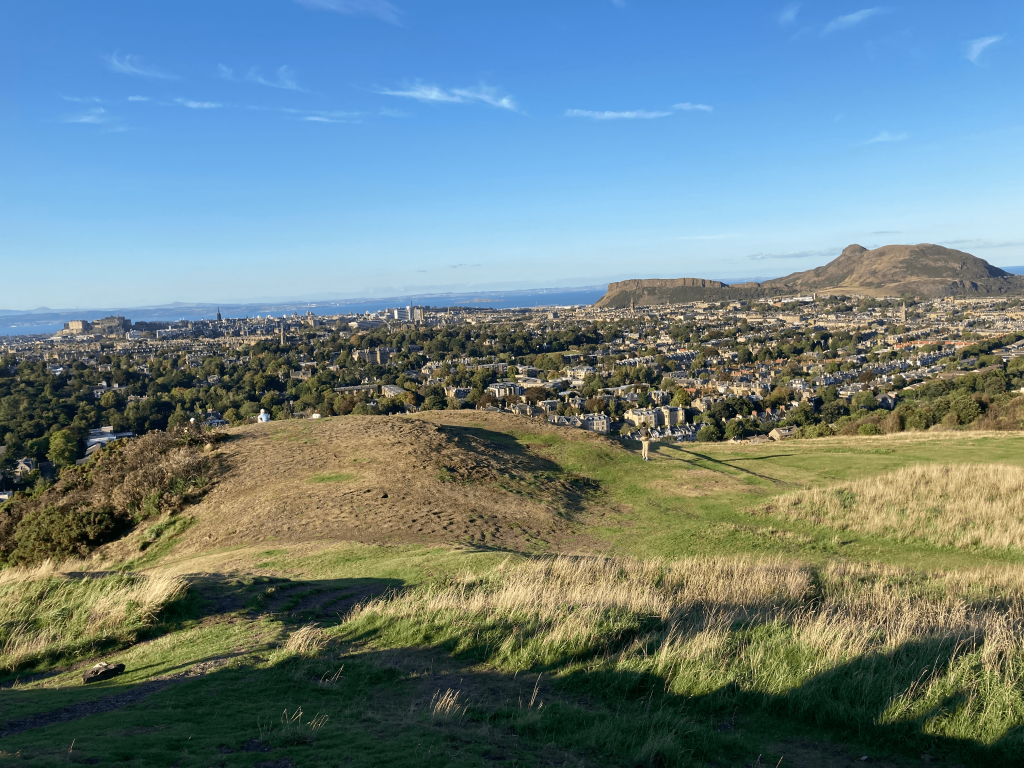
Planet Hunters NGTS: More detail on our first four Planet Candidates
You may have seen my previous post announcing that we have 4 new planet candidates discovered by Planet Hunters NGTS, if not you can find it here. We wanted to give you some more information on what we know about each candidate so far and the efforts we’ve made to gather follow-up data as we work towards ascertaining whether or not they’re real exoplanets! The first step once we decided that these candidates were worthy of further investigation was to fit the data using a more intricate model. This is typically what’s meant by phrases like “modelling estimates” or “fit results” that you may see below or in other pieces of science communication. Each of these candidates pose their own unique challenges in being able to confirm whether they’re really planets, however to already have 4 planet candidates is a promising sign for the future of the project and a real testament to the brilliant work put in by you, the Planet Hunters NGTS volunteers.
Subject 69695263: This is our most promising candidate so far as the transits look quite clear and our modelling estimates give encouraging results. We think this is a hot Jupiter orbiting a “K dwarf star,” which is a star slightly smaller and cooler than our Sun. We’ve estimated that the planet candidate has a radius equal to 1.09 times the radius of Jupiter, which we write as Rp=1.09 RJup. It orbits its host star every 1.74 days which means by the time you turn 18 Earth-years-old, you’d be almost 3800 years-old on this planet candidate (if it exists, and assuming you could live on it, which you can’t). We have received data from the Zorro team for this candidate (read more about the Zorro instrument and our follow-up efforts here), and it shows that the host star is isolated from other stars as far as we can tell, which means that we can be slightly more confident that this isn’t a false positive signal caused by an eclipsing binary! There’s still plenty of work to do before we can approach the possibility of confirming or validating this as a planet, but we’re cautiously optimistic about this candidate.

This candidate has been causing something of a headache since we only managed to observe one full transit and a number of partial transits (i.e. we only see the start or end of the transit). We have estimated that the potential orbiting body has an orbital period of 3.97 days however our radius estimates range from Jupiter-sized up to a radius not much smaller than our Sun. This suggests we could have a planet candidate but it could also be what’s known as an eclipsing binary with low mass (EBLM). While these are interesting systems, they’re not the planets we’re looking for! We do have Zorro data for this candidate and we can’t see another star nearby however it’s possible that the signal could be a false positive caused by “systematics” which is a general term for any trend in the data that might not have been accounted for during processing.

Much like the candidate above, this candidate is a troublesome one. The transits appear to be grazing (check out this post for a description of grazing transits) which makes it tricky to get a good estimate of the radius of the candidate. The radius of the planet candidate is estimated to be at least Rp=1.50 RJup which is already at the upper limit for what we believe can be a planet. Our upper estimate of the radius is one solar radius, meaning this could be a standard eclipsing binary. Sadly we don’t have Zorro data for this candidate to be able to check this just yet. This candidate, and the previous one, will require some more investigation to really understand what they actually are.
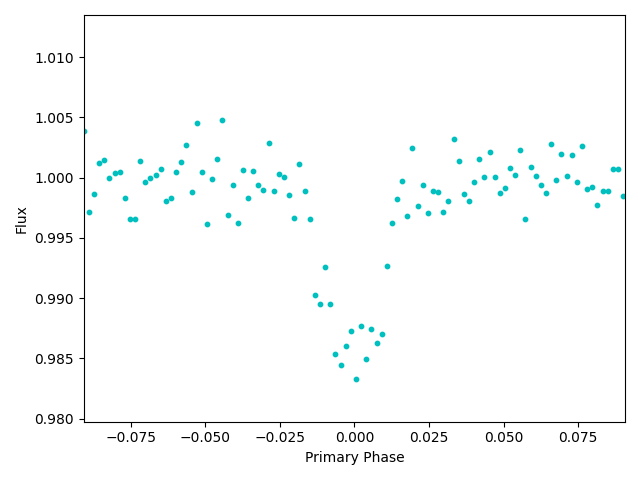
Lastly, this candidate is very exciting because if our initial estimates are correct, this would be one of only a handful of discoveries to date of giant planets orbiting close to their small host star. The transit depth of ~12% is much deeper than we typically expect for exoplanet transits, however the host star has a radius equal to only 1/3rd the radius of our Sun. Therefore, we believe this could be a hot Jupiter, with a radius of Rp=1.13 RJup, orbiting an M dwarf star on a 2.10 day period. These types of systems are very rare and really surprising to find because our current understanding of how planets form suggests that such a large planet shouldn’t be able to form around such a small star because there simply shouldn’t be enough time for it to form or planet building material available. The Zorro data for this candidate is also encouraging as we see no companion stars. We hope to gather more data on this object in the coming months if possible, so stay tuned!

These four NEW candidates are really exciting! They weren’t spotted in the initial check of the data by the NGTS team which means that the Planet Hunters NGTS project has proven it really has the potential to be a complimentary search to help NGTS discover as many planets as possible. We couldn’t have done this without the help of everyone who’s classified subjects on Planet Hunters NGTS and we’re eager to see what else you can help us find in the future as there are still plenty of subjects to be classified! I’ll be presenting these candidates next week at the UK Exoplanet Meeting in Edinburgh before checking the latest results from the project for more possible planet candidates. We’ll also be starting to write up the first results from the project into a paper to be submitted to an academic journal!
Planet Hunters NGTS: Potential Planet Candidates
Today, I presented the latest Planet Hunters NGTS results at the UK’s National Astronomy Meeting in the University of Warwick. Good news everyone! I am very excited to announce that we have four new planet candidates have been found by Planet Hunters NGTS. In addition, we have been able to get some observations of three of these new potential planet candidates with the Gemini South telescope in Chile!
I have spent the past several months developing a software pipeline to combine all of your assessments together for the various workflows that make up the website. This sifts through the candidates output from the NGTS algorithms to look for any new possible planets. In my preliminary search through the classifications available, I took the best candidates that were classified in the Secondary Eclipse Check and Odd/Even Transit Check and shared our findings with the rest of the NGTS team. Four of these candidates look like possible planet transiting planets and are shown in Figure 1.

There’s a lot of work that needs to be done to go from planet candidate to bonafide planet, so the four objects are still planet candidates. To confirm possible transit events requires using additional detection methods to get the mass of the orbiting body that confirm it has a mass less than a star or additional observations that can help statistically rule out the possible astrophysical false positives that can mimic planet transits (like eclipsing binaries). These candidates are around faint stars which will make validating these planets a tricky process.
Three of our planet candidates were observed in the past month to get follow-up observations. We worked with our collaborators in the US to apply for observing time on the Gemini South telescope. This involves: justifying why our candidates are interesting (there’s a lot of really interesting science that people want to do that we have to compete with!); justifying why the Gemini telescopes and Zorro instrument (see next paragraph) are the best tools for the job (in this case, Zorro is one of only a few instruments in the world that can carry out the kind of observation we need, another being ‘Alopeke on the Gemini North telescope in Hawaii); and calculating how much time we’d need to use the telescope for.
The instrument we are using is the ‘Zorro Speckle Imager.’ Zorro takes lots of images of the star in quick succession, which allows us to “freeze out” the effects of the Earth’s atmosphere that causes light from stars to be distorted (this effect is known as atmospheric seeing, see Figure 2). This allows us to spot whether there are any other stars so close to our targets that the NGTS telescopes couldn’t tell them apart. These background stars contaminate the light we measure for the main target star and dilute eclipsing binary light curves such that we can’t see the secondary transits, mimicking what we would observe for a true transiting planet. This isn’t a design flaw in NGTS but a reality of how different telescopes are built for different purposes. For example, Zorro isn’t designed to survey our targets for the long timespan, like NGTS has, in order to spot these transits in the first place. Using different telescopes for exoplanet follow-up and confirmation is much like a football (soccer) team: if the defenders don’t win the ball from the opposition (NGTS spotting transits), they can’t then pass it to the midfielders to move it up the pitch (Zorro checking for other stars).
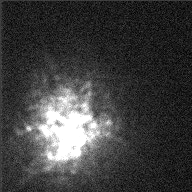
Our observations were carried out by the excellent team of astronomers and support staff at Gemini and NASA a few weeks ago and we’re hoping to be sent the full final results soon.
What about the strikers in our analogy? If we find out that these targets are solo stars, that isn’t the final step in confirming an exoplanet (it’s also a big IF). We’d ideally take “radial velocity” measurements which allow us to measure the mass of the exoplanet. This technique works by detecting how much a star is “wobbling.” This wobbling is caused by the exoplanet orbiting the star and the amount of wobble relates to how much mass the exoplanet has. When we say the planets orbit the Sun, really we mean the planets AND the Sun orbit the entire Solar System’s common centre of mass. It just happens to be that this point is very close to the Sun since it’s so big. It’s the same story for exoplanets and their stars. The radial velocity measurements take the role of the striker in our analogy, although it’s important to say that this wouldn’t be the end of it and there’s still plenty other tests to do and data that we have to gather to confirm if any of these candidates are real exoplanets. If we’re unable to take radial velocity measurements then we can potentially use “multicolour photometry” to help towards validating the candidate. This involves checking whether the depth of the transit is the same when we observe the star with different filters on a telescope. These filters only let certain colours of light through, similar to how you’d mainly see pink if you wore Elton John’s famous tinted glasses. If there’s a difference in the depth then it suggests that there is a background eclipsing binary system that is mimicking the transit of an exoplanet. The difference in depth would be because stars have different colours depending on how hot they are, so if we see a shallower or deeper transit using a different filter it is because a background star isn’t as bright in that filter. For these four stars, getting radial velocity observations will be tough as they are very faint and would require lots of time on the world’s largest telescopes, but the first step is to see what the Zorro observations say. Once we can analyse and interpret the Zorro data, we will decide on the next steps.
It’s very exciting to have candidates. Even if we can’t confirm these candidates as official planets, just finding these is an important step. We can still use these planet candidates to estimate the rate of exoplanets around the stars observed by NGTS. Thank you to everyone who has contributed to our project so far, whether it’s been through classifying light curves or getting involved with discussing potential candidates and weird subjects on the Talk boards. We couldn’t have done this without you. Also thank you to the extremely helpful team of instrument scientists at Gemini who helped us to setup our observations and the team at NASA for processing our data.
We also have many more subjects from the Exoplanet Transit Search still to sift through with the Secondary Eclipse and Odd/Even Transit checks. I performed an initial search, so there is much more I will be doing in terms of analysis of the classification data over the next many months. I am very hopeful that there will be even more candidates to find! Stay tuned! We’ll keep everyone posted on the blog.
Planet Hunters NGTS: NI Science Festival
Last week was the Northern Ireland Science Festival, which aims to promote all kinds of science being done across the country and beyond! Since Planet Hunters NGTS is run primarily by researchers at Queen’s University Belfast, we, along with colleagues across the Astrophysics Research Centre, decided we’d get involved by making some videos to excite people about astronomy and hopefully try to teach some real science along the way.
Always looking for ways to promote Planet Hunters NGTS and get more people involved with hunting for exoplanets, we saw this as the perfect opportunity to advertise the project, and what better way to do so than to film a fast-talking, used-car salesman-style infomercial including some whacky special effects. You can watch the minute-long clip on YouTube here!
But that’s not all, Planet Hunters NGTS also became the sponsor of the fictitious Astro News Bulletin. The science is real and the bad jokes are sadly real, but you won’t find these newscaster on any mainstream channel.
There are 8 other excellent videos from members of the Astrophysics Research Centre to watch by following the link to the playlist here. Take a tour of some exoplanets; bake a comet; or see what it is us astronomers do all day!
